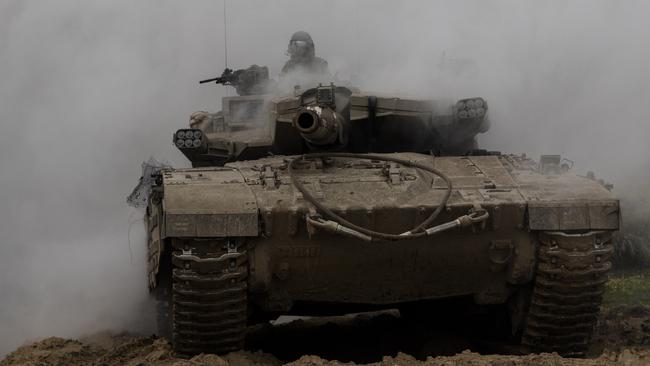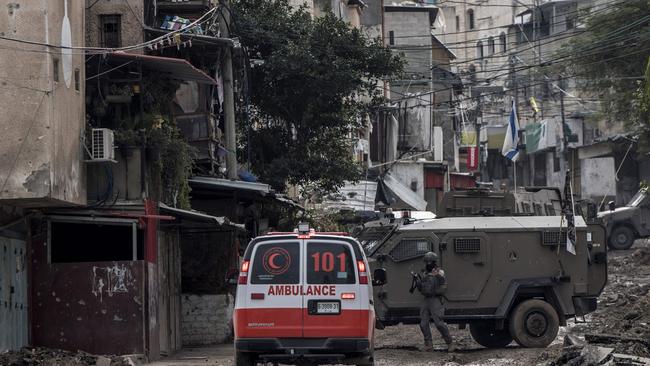Under pressure Israel pulls thousands of troops from Gaza
Decision shows how Israel feels beholden to international pressure to be more surgical in its operations.

Israel withdrew thousands of troops from Gaza following pressure from the U.S. to transition to a more surgical phase of its war against Hamas, a move that has sparked concerns among some Israeli officials that the pullout could leave the country vulnerable to another surge in militant activity.
The decision to withdraw one of Israel’s four divisions in Gaza provides Israel with more bandwidth to deploy forces to other flashpoints, such as unrest in the West Bank, that have emerged since the start of Israel’s invasion of Gaza. In drawing down its forces in the strip, however, Israel risks undermining its strategic goal of eradicating Hamas, exposing the country to renewed attacks.
Those concerns were underscored earlier this week when a heavy barrage of rockets was fired from central Gaza, according to the Israeli military, an area where the 36th Division had been operating until it was withdrawn a day earlier. The barrage was fired from a position a little more than a quarter mile from a group of Israeli forces, said the Israeli military’s head spokesman, Rear Adm. Daniel Hagari.
Israel currently has three divisions battling in Gaza, with one each in Gaza’s north, center and southern zones, Hagari said. Its broadest deployment is in Hamas’s southern stronghold of Khan Younis, where Israel began fighting from the eastern part of the city and has now moved into the southern part of the city, he said. Hagari said the 36th Division was rotated out to rest and train.
Giora Eiland, a retired Israeli general, said Israel’s shifting tactics will enable more civilians, and militants along with them, to trickle back into northern Gaza. “We paid a very high price for something that is going to have no meaning in a short time,” he said.
Israel’s heavy bombardment of Gaza, combined with sweeping ground operations, has resulted in heavy casualties for Palestinian civilians as well as an outcry from key Western allies. The U.S. has called on Israel to both reduce troops in Gaza and enable a portion of the estimated 90% of Gazans displaced by the war to return to their homes.
It is unclear whether the division would be later redeployed to Gaza, but the move, announced earlier this week, shows the extent to which Israel feels beholden to international pressure. It also exposes the thorny issue of what constitutes a strategic military victory in a place where Hamas has embedded itself into the fabric of everyday life since usurping total control in 2007.

Ahron Bregman, a political scientist at King’s College in London and former officer in the Israeli military, said that, short of an all-out victory over Hamas, Israel may have to satisfy itself with less ambitious war aims.
“Even though Israel would never officially admit it, the aim of toppling Hamas can’t be achieved, neither now or in the future,” he said.
Israeli Prime Minister Benjamin Netanyahu said Wednesday that he stuck by the originally stated war goals of eliminating Hamas.
“This war is continuing and will continue until the end, until we have hit all our goals,” Netanyahu said.
The U.S. has been working to keep the war from expanding into a wider conflict. Attacks by Houthi rebels in Yemen on ships transiting the Red Sea have led to strikes on the group by U.S.-led forces, underscoring the risk. On Wednesday, a Marshall Islands-flagged ship was hit by a drone as it sailed 66 nautical miles southeast of Aden, Yemen, said the United Kingdom Maritime Trade Operations, a British mission assisting merchant vessels in the region. The vessel sustained damage and received assistance from an Indian warship, British security consulting firm Ambrey said.
The Houthis later claimed responsibility for the attack on a U.S.-owned bulk carrier called the Genco Picardy. Its owner, New York-based Genco Shipping & Trading Ltd., said the vessel had been targeted by an unidentified projectile while transiting through the Gulf of Aden with a cargo of phosphate rock. “All seafarers aboard the vessel are confirmed to be uninjured,” the company said, adding that the gangway had limited damage.
Washington has repeatedly pushed for more surgical operations in Gaza that would allow for freer distribution of humanitarian aid to Gazans and limit the number of civilians killed in the conflict. More than 24,000 Palestinians have been killed since the war began, the majority of them women and children, according to Palestinian health authorities, whose numbers don’t distinguish between combatants and civilians. The invasion was triggered by Hamas’s Oct. 7 incursion into southern Israel, where militants killed more than 1,200 people, mostly civilians, according to Israeli officials.
White House National Security Council spokesman John Kirby said Tuesday that while Hamas remained a threat to Israel, Washington didn’t want to see any more civilian deaths.
“We’ve encouraged Israel, particularly now as it shifts to this new phase, to do so, in terms of their operations, as surgically and as precisely as possible to minimize those casualties,” he said during a briefing.
Israel’s Foreign Ministry said two hostages, Yossi Sharabi and Itay Svirsky, had been killed by Hamas, which highlights the urgency to secure the release of 132 hostages, including 27 bodies, that the Israeli prime minister’s office says are still held by the militant group in Gaza.
The Israeli troops’ withdrawal comes as Israel faces renewed pressure elsewhere, including in the West Bank, the site of three Israeli raids early Wednesday, which killed at least nine Palestinians. The Israeli military said an attack on a car in Nablus killed militants planning future attacks. Since the start of the Gaza invasion, tensions have risen in the occupied territory, where Palestinians have faced increased unemployment after Israel closed entry to laborers from the West Bank.
Sa’d Nimer, a political-science professor at Birzeit University in the West Bank, said in an interview that increased severity in the military’s attempts to root out pockets of militancy was backfiring, causing it to grow instead.
Eiland, the retired general, said that while Israel has aggressively sought to suppress the opening of a military front in the West Bank, it may not have the ability to prevent another large-scale uprising in the shape of previous intifadas.
“Tactically we are very successful in the West Bank but I don’t think Israel can prevent a popular uprising,” he said.
The U.S. has engaged with the Palestinian Authority, which nominally rules the West Bank. Efforts to create a Palestinian state are central to bringing an end to the conflict in the Middle East, said Secretary of State Antony Blinken on Wednesday.
In the past, he said, Palestinians and the wider Arab world were criticized for not accepting the idea. Now, he said, the challenge is whether or not Israeli leaders are willing to embrace that idea in the wake of Oct. 7.
“The question now is: [Is] Israeli society prepared to engage on those questions?” Blinken said in Davos, Switzerland, on Wednesday. “Is it prepared to have that mindset? That’s challenging.”
Dion Nissenbaum, Benoit Faucon and Saleh al-Batati contributed to this article.
The Wall Street Journal



To join the conversation, please log in. Don't have an account? Register
Join the conversation, you are commenting as Logout